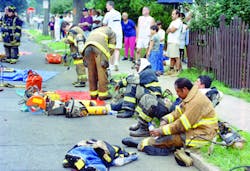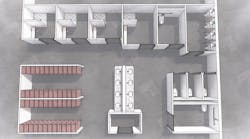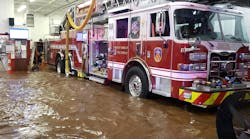2:45 A.M. The 14th call of the shift. Fire rages in a multi-story structure. Arriving on the scene, firefighters note several lighted windows of occupied rooms. Moments later, the power is cut. Remembering the location of these rooms – and their potential occupants – may be the difference between life and death. To what extent is the ability to perform this task compromised by the fact that these firefighters have been running calls all day long? What is the relationship between excessive call volume and cognitive fatigue?
While considerable research has highlighted the dangers of physical fatigue, the idea that cognitive abilities like attention and memory may become impaired by a high work load is relatively unexplored. It is well established that fatigue has negative consequences on the immune system, emotional resilience and social interactions, and it stands to reason that the speed and accuracy of decision making is also at risk when job demands become excessive.
Because so many fire departments are facing budget cuts, and because this frequently requires cutting jobs and increasing the workload on the remaining firefighters, it is imperative to explore the consequences this will have on mental and physical readiness. Of particular interest is the extent to which high call volumes may compromise cognitive functioning in real-world tasks, like the ability to remember the occupied rooms in the opening vignette.
Case Study: Mesa, AZ
In 2005, the Mesa, AZ, Fire Department (MFD) had 23 pieces of apparatus serving a population of 443,000 in a 132-square-mile jurisdiction. With 61,000 calls that year, the average number of calls per apparatus was 2,652 – more than twice that of many cities comparably sized in terms of both population and jurisdiction (e.g., Atlanta, GA; Fresno, CA; Tulsa, OK; and Kansas City, MO). Moreover, in 2005, 45% of Mesa’s units responded to more than 3,000 calls. According to TriData, a consulting firm that has conducted more than 150 studies of fire departments, annual responses of 3,000 to 3,200 not only create response time and availability issues, but also fatigue problems with crew members. In other words, there is a direct correlation between the number of responses and fatigue.
Concerned over the potential toll of excessively high call volumes, MFD’s Critical Incident Stress Management (CISM) Team authored a report highlighting the importance of adequate sleep for the health and well-being of the city’s firefighters. The literature review revealed a relative dearth of research directly related to the cognitive impact of high call volume on firefighters’ on-the-job performance and several critical questions remained unanswered:
- To what extent do firefighters subjected to stresses of 10 or more calls in a 24-hour shift also show cognitive impairment?
- Do they make more errors in simple decision tasks?
- Does memory suffer?
- Does it take them longer to make decisions that need to be made in a split second?
To address these questions, CISM team members Greg Adams, Michele Adamczyk and Steve Ward initiated a collaboration with Dr. Vaughn Becker, a cognitive psychologist at Arizona State University Polytechnic, and K.C. Blackwell, a quantitative psychologist at Arizona State University. Using state-of-the-art memory and reaction-time tasks (tasks that are often used to examine cognitive impairment that results from intoxication or dementia), the researchers worked with designers at the Internet development consortium Redfish Group to develop a series of web-based computerized assessments designed to evaluate the extent to which critical facets of job-relevant cognitive functioning are impacted by call volume.
The selection and development of the assessments was based on the U.S. Department of Labor’s Dictionary of Occupational Titles, which provides comprehensive details of the specific abilities required for performing the job of a municipal firefighter. This information, in conjunction with consultation with local firefighters serving as subject-matter experts, formed the basis for a series of computer games designed to tap cognitive abilities directly relevant to tasks performed in the line of duty.
Pilot Study
The first study, completed in the summer of 2007, was administered via the Internet. Each participant logged onto a website with an anonymous ID number and a password of their choosing. Every session began with a set of questions about the stress and call volume for the shift. Participants were then guided through a set of two of cognitive tasks targeting four specific facets of cognitive functioning.
The first of these games was based on the card game commonly known as “Concentration” in which pairs of matching cards are placed face down and are turned over two at a time, with the goal of matching all pairs of cards in as few turns as possible. The study’s computerized version used photos of fire equipment concealed behind virtual tiles. This task provided a measure of spatial orientation and memory for location, as well as the degree to which similar items were confused with one another.
The second game used a visual search task in which participants were asked to rapidly search an array of colored letters for a particular letter of a particular color. This provided a measure of the speed with which the target could be found, as well as a measure of the number of “false alarms” that were made when the target was not present in the array. This task also measured two of the most important cognitive abilities of a municipal firefighter (according to the U.S. Department of Labor; see http://www.occupationalinfo.org/onet/63008a.html): response orientation – “the ability to choose quickly and correctly between two or more movements in response to two or more signals” – and flexibility of closure – “the ability to identify or detect a known pattern (a figure, object, word, or sound) that is hidden in other distracting material.”
Nineteen firefighters at six stations participated in at least six sessions of data collection each, which provided sufficient data to control for practice effects. Results clearly indicated that the overall time needed to detect targets in the visual search task increased with increasing call volumes. Specifically, after 10 calls, participants typically slowed down by one-fifth of a second or more. Notably, however, there was not a statistically significant increase in the number of false alarms with increasing call volumes. This suggests that participants who had experienced a higher number of calls – and were therefore more likely to be cognitively fatigued – slowed down in their response times in order to maintain consistently high accuracy. This shows a situational awareness and an ability to compensate for fatigue that is commendable and makes the best of a bad situation.
The “Concentration” game produced trends in the same direction, though the declines in memory were not statistically significant (likely due to the small sample size). It should be noted, however, that compared to similar studies using introductory psychology students at Arizona State University, college students did perform significantly worse on this task when they were tired (i.e., when tasks were performed in the evening prior to going to sleep), which suggests that firefighters were able to resist the effects of cognitive fatigue better than many in the general population. This pilot study motivated the team to pursue a second, more controlled study in the late winter and spring of 2008.
Primary Study
The second study featured two different cognitive tasks designed to target a wider array of requisite on-the-job abilities. In the first task, participants were shown an image of a building with 12 windows. Six of these windows were lighted, indicating that they were potentially occupied. After four seconds, all the lights went out (mimicking the power cut in the scenario that opened this article). Participants were then asked to recall which of the windows were potentially occupied. This provided measures of spatial and response orientation, as well as selective spatial attention and response time.
In the second task, participants were asked to memorize a small set of letters, and then indicate whether individually presented “probe” letters were in this mental inventory. This task is widely used in the psychological literature to measure declines in cognitive ability, and provided additional indices of response orientation and reaction time, as well as a measure of the time needed to scan a mental inventory.
Error rates in the window-memory task show the effects of increasing call volumes the most clearly. Figure 1 shows an increasingly severe impact of call volumes after 10 calls per shift is exceeded. Indeed, for firefighters who had been on 17 calls (a situation frequently encountered and exceeded in this population), the error rate is approximately double what it is for low call volumes. In other words, these cognitively fatigued firefighters forgot twice the number of occupied rooms as their well-rested colleagues. It is important to note however, that these effects were only acute in those who were unable to obtain in-service rest and recovery periods (colloquially referred to as “safety naps”). Scheduling such a rest and recovery period should be an important tool in combating the effects of cognitive fatigue when other measures cannot be taken.
In the second task, firefighters scanned a mental inventory (a list of letters) as quickly as possible to determine whether the list included a particularly item. This memory scanning method is widely used in psychological investigations of cognitive impairment, for example in elderly populations and in the assessment of drug side effects. Figure 2 shows that at higher call volumes there was an accumulating cost in terms of reaction time. For example, when we compare 10 calls versus three, there was an increase of a quarter-second in overall response speed, but the increase for 17 calls versus. 10 (which is the same relative amount of increase) carried with it an additional two-fifths of a second of an increase in the time it took to detect the target. This delay in reaction time could have profound effects for on-the-job performance. Although seemingly small, a one-fifth-of-a-second delay in response time can be the difference between a serious accident on the road and applying the brakes in time to avoid running into another motorist who has rapidly slowed down.
In addition to the tasks measuring the accumulating effects of cognitive fatigue, the researchers also looked at practical consequences of the slowdown in decision making and increase in errors. One important consequence was a dramatic spike in the number of industrial and accident reports that were filled out. Figure 3 clearly shows that these rates were relatively low – fewer than 4% of shifts required such reports – until call volumes exceeded 12 per shift, at which point the number quadrupled to 16.3%. Cognitive fatigue is a likely cause of the lapses and delays in judgment that led to such an increase in accidents.
Conclusions and Future Directions
These two studies clearly suggest that high call volumes have consequences that go beyond physical and emotional fatigue, affecting memory and the speed and accuracy of decision making. Such cognitive fatigue is relatively unstudied in first-responder populations, but the consequences associated with it are of critical importance and should inform public policy. Most notably, the current results suggest that call volumes for any apparatus should not exceed 10 calls in a 24-hour period. While there will always be days that involve workloads in excess of this, cities should endeavor to allocate resources so as to minimize these occurrences.






